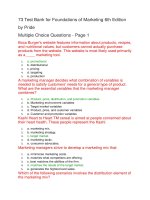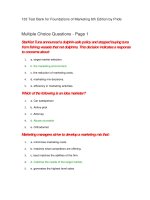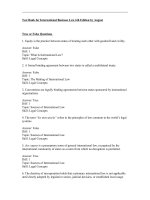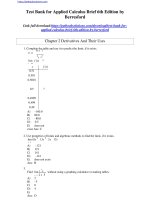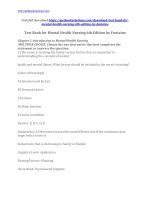Test bank for managers and the legal environment strategies for the 21st century 6th edition by bagley
Bạn đang xem bản rút gọn của tài liệu. Xem và tải ngay bản đầy đủ của tài liệu tại đây (269.92 KB, 11 trang )
buy this full document at
CHAPTER 1
Law, Value Creation, and Risk Management
TRUE FALSE QUESTIONS
1.
Private law provides the legal rules within which firms compete.
ANSWER: False
SKILL LEVEL: AACSB Analytic
OBJECTIVE: AICPA Legal
2.
Managers can make their own “public” law.
ANSWER: False
SKILL LEVEL: AACSB Analytic
OBJECTIVE: AICPA Legal
3.
An insight of the “stakeholder” theory is that firms have relationships with many constituent
groups.
ANSWER: True
SKILL LEVEL: AACSB Ethics
OBJECTIVE: AICPA Legal
4.
Researchers have determined that Fortune 500 firms convicted of illegal conduct earned
significantly lower returns on assets than firms that had not been convicted of wrongdoing.
ANSWER: True
SKILL LEVEL: AACSB Ethics
OBJECTIVE: AICPA Legal
5. Lobbying legislators is one method by which managers can help shape the environment in which
they do business.
ANSWER: True
SKILL LEVEL: AACSB Ethics
OBJECTIVE: AICPA Critical Thinking
6.
Laws enacted in response to corporate misdeeds often impose fewer restrictions and costs on
business than would have been imposed had firms acted more responsibly at the outset.
ANSWER: False
SKILL LEVEL: AACSB Analytic
OBJECTIVE: AICPA Legal
7.
Promoting economic growth is one of the primary public policy objective of laws and regulations
applicable to business.
ANSWER: True
SKILL LEVEL: AACSB Reflective Thinking
buy this full document at
2
LAW, VALUE CREATION, AND RISK MANAGEMENT
OBJECTIVE: AICPA Critical Thinking
8.
Worker protection is one major public policy concern underlying U.S. business law.
ANSWER: True
SKILL LEVEL: AACSB Ethics
OBJECTIVE: AICPA Critical Thinking
9.
Supervisory boards of large German corporations are elected entirely by the shareholders.
ANSWER: False
SKILL LEVEL: AACSB Diversity
OBJECTIVE: AICPA Legal
10.
As used in the text, the term “legal astuteness” refers to the ability of a manager to avoid
situations making consultation with legal counsel necessary.
ANSWER: False
SKILL LEVEL: AACSB Analytic
OBJECTIVE: AICPA Legal
11.
12.
It is the job of the general manager of a business, not the lawyer, to decide which allocation of
resources and rewards makes the most business sense.
ANSWER: True
SKILL LEVEL: AACSB Analytic
OBJECTIVE: AICPA Legal
A legally astute manager would wait as long as possible to consult legal counsel once a problem
arises in order to keep legal fees to a minimum.
ANSWER: False
SKILL LEVEL: AACSB Analytic
OBJECTIVE: AICPA Critical Thinking
13.
A legally astute manager understands that legal analysis is often ambiguous.
ANSWER: True
SKILL LEVEL: AACSB Analytic
OBJECTIVE: AICPA Critical Thinking
14.
The choice of business entity will determine the investors’ liability for the debts of the business.
ANSWER: True
SKILL LEVEL: AACSB Analytic
OBJECTIVE: AICPA Legal
15.
The European Union’s center of operations is in Brussels, Belgium.
ANSWER: True
SKILL LEVEL: AACSB Analytic
OBJECTIVE: AICPA Legal
Full file at />16. When a criminal investigation appears likely, managers should act immediately to advise
employees to destroy electronic documents, such as e-mails, pertaining to the matter under
investigation.
ANSWER: False
SKILL LEVEL: AACSB Ethics
OBJECTIVE: AICPA Critical Thinking
17.
Managers are ethically prohibited from providing independent legal representation for employees
when a company is confronted with a criminal investigation.
ANSWER: False
SKILL LEVEL: AACSB Ethics
OBJECTIVE: AICPA Legal
18.
Employee statements are a primary investigatory source when corporate wrongdoing
is alleged.
ANSWER: True
SKILL LEVEL: AACSB Analytic
OBJECTIVE: AICPA Legal
19.
The Election Act of China gives business people the right to be elected as congresspersons.
ANSWER: True
SKILL LEVEL: AACSB Diversity
OBJECTIVE: AICPA Legal
20.
Corporate officials cannot be held criminally liable for wrongdoing on behalf of a corporation.
ANSWER: False
SKILL LEVEL: AACSB Analytic
OBJECTIVE: AICPA Legal
MULTIPLE CHOICE QUESTIONS
1.
Which of the following is not one of the four primary public policy objectives of the laws and
regulations applicable to U.S. business in the early twenty-first century?
A. Promoting economic growth
B. Protecting workers
C. Promoting public welfare
D. Promoting governmental regulation
ANSWER: D
SKILL LEVEL: AACSB Analytic
OBJECTIVE: AICPA Legal
2.
Managers can make their own ______ law by entering into contracts and crafting certain
governance structures.
A. Public
B. Primary
C. Cohesive
D. Private
ANSWER: D
4
LAW, VALUE CREATION, AND RISK MANAGEMENT
SKILL LEVEL: AACSB Analytic
OBJECTIVE: AICPA Legal
3.
The ______ approach recognizes that “business decisions consist of continuous, interrelated
economic and moral components” and that “the moral aspects of choice” are the “final component
of strategy.”
A. Procedural
B. Systems
C. Conciliatory
D. Mandated
ANSWER: B
SKILL LEVEL: AACSB Analytic
OBJECTIVE: AICPA Legal
4.
Which of the following is a theory that recognizes that firms have relationships with many
constituent groups which both affect and are affected by the actions of the firm?
A. Stakeholder
B. Stockholder
C. Relational
D. Cohesive
ANSWER: A
SKILL LEVEL: AACSB Ethics
OBJECTIVE: AICPA Legal
5.
Which of the following recognizes that a firm’s resources can be a source of sustained
competitive advantage if they are valuable, rare, and imperfectly imitable by competitors, and
have no strategically equivalent substitutes?
A. The value-response theory
B. The corporate –resource view
C. The resource-based view
D. The competitive-advantage view
ANSWER: C
SKILL LEVEL: AACSB Analytic
OBJECTIVE: AICPA Legal
6.
Which of the following is true regarding legally astute management teams practicing strategic
compliance management?
A. The cost of complying with government regulation is viewed as an investment, not an
expense.
B. The cost of complying with government regulation is viewed as an expense which should be
avoided until legal action is threatened.
C. Only the minimum necessary to comply with any applicable law should be done.
D. Both that the cost of complying with government regulation is viewed as an expense which
should be avoided until legal action is threatened and that only the minimum necessary to comply
with any applicable law should be done.
ANSWER: A
SKILL LEVEL: AACSB Analytic
OBJECTIVE: AICPA Legal
Full file at />7.
Which of the following is a way in which managers can help shape the legal environment in
which they do business?
A. By lobbying legislators
B. By forming coalitions
C. By refusing to follow laws viewed as unneeded by company officials
D. By lobbying legislators and by forming coalitions, but not by refusing to follow laws viewed
as unneeded by company officials
ANSWER: D
SKILL LEVEL: AACSB Ethics
OBJECTIVE: AICPA Legal
8.
Which of the following is a type of law referencing formal rules embodied in constitutions and
statutes enacted by legislatures?
A. Public
B. Private
C. Substantive
D. Remedial
ANSWER: A
SKILL LEVEL: AACSB Analytic
OBJECTIVE: AICPA Legal
9.
Which of the following is a type of law referencing formal rules embodied in judicial decisions
rendered by courts?
A. Public
B. Private
C. Substantive
D. Remedial
ANSWER: A
SKILL LEVEL: AACSB Analytic
OBJECTIVE: AICPA Legal
10.
What percentage of the members of supervisory boards of large German corporations are elected
by the workers and unions?
A. 80
B. 75
C. 50
D. None
ANSWER: C
SKILL LEVEL: AACSB Diversity
OBJECTIVE: AICPA Legal
11.
What percentage of the members of supervisory boards of large German corporations are elected
by shareholders?
A. 80
B. 75
C. 50
D. None
ANSWER: C
SKILL LEVEL: AACSB Diversity
OBJECTIVE: AICPA Legal
6
12.
LAW, VALUE CREATION, AND RISK MANAGEMENT
Which of he following is not a way in which laws and regulations promote economic growth?
A. By refusing to enforce private agreements
B. By protecting private property rights
C. By allocating risks
D. By facilitating the raising of capital
ANSWER: A
SKILL LEVEL: AACSB Analytic
OBJECTIVE: AICPA Legal
13.
Which of the following is a way in which U.S. business law promotes worker protection?
A. By requiring the employer to provide certain benefits
B. By regulating certain terms and conditions of employment
C. By protecting workers’ civil rights
D. All the responses are correct
ANSWER: D
SKILL LEVEL: AACSB Analytic
OBJECTIVE: AICPA Legal
14.
Which of the following is a way in which U.S. business law promotes consumer welfare?
A. By encouraging the sale of safe products at a fair price
B. By preventing deceptive practices
C. By refusing to recognize consumer privacy
D. By encouraging the sale of safe products at a fair price and by preventing deceptive practices,
but not by refusing to recognize consumer privacy
ANSWER: D
SKILL LEVEL: AACSB Analytic
OBJECTIVE: AICPA Legal
15.
What was the court’s ruling in the case of Image Technical Services v. Eastman Kodak Co.
discussed in the text?
A. That Kodak’s intellectual property rights in patented parts established a legitimate business
justification for refusing to sell those specialized parts to an independent service organization
only if service of Kodak machines constituted less than 75 of the business of any independent
service organization.
B. That Kodak’s intellectual property rights in patented parts established a legitimate business
justification for refusing to sell those specialized parts to an independent service organization
only if service of Kodak machines constituted less than 50 of the business of any independent
service organization.
C. That Kodak’s intellectual property rights in patented parts established a legitimate business
justification for refusing to sell those specialized parts to an independent service organization
only if service of Kodak machines constituted less than 25 of the business of any independent
service organization .
D. That Kodak’s intellectual property rights in patented parts did not establish a legitimate
business justification for refusing to sell those specialized parts to independent service
organizations.
ANSWER: D
SKILL LEVEL: AACSB Technology
OBJECTIVE: AICPA Legal
Full file at />16. Which of the following is a term addressing the ability of a manager to communicate effectively
with counsel and to work together to solve complex problems?
A. Legal astuteness
B. Conciliatory interaction
C. Mediation
D. Arbitration
ANSWER: A
SKILL LEVEL: AACSB Communication
OBJECTIVE: AICPA Legal
17.
Which of the following has the responsibility for deciding which allocation of resources and
rewards in a business makes the most business sense?
A. The general manager
B. The in-house lawyer
C. An independently retained lawyer
D. An independently retained law firm, not just one lawyer
ANSWER: A
SKILL LEVEL: AACSB Analytic
OBJECTIVE: AICPA Legal
18.
Which of the following is not a component of legal astuteness?
A. A set of value-laden attitudes about the importance of law to the firm’s success
B. A reactive approach to regulation
C. The ability to exercise informed judgment when managing the legal aspects of business
D. Context-specific knowledge of he law and the appropriate use of legal tools
ANSWER: B
SKILL LEVEL: AACSB Analytic
OBJECTIVE: AICPA Legal
19.
Which of the following is listed in the text as a component of managing risk when assembling a
team in business development?
A. Analyzing any covenants not to compete
B. Purposefully refusing to address issues such as sexual harassment at such an early stage
C. Informing employees regarding the e-mail communications are not discoverable
D. Refusing to provide whistleblower protection
ANSWER: A
SKILL LEVEL: AACSB Analytic
OBJECTIVE: AICPA Legal
20.
Which of the following is listed in the text as a component of managing risk in the harvesting
stage of business development?
A. The encouragement of insider trading
B. The ban of police trades
C. Incomplete disclosure in prospectus
D. Incomplete disclosure in acquisition agreement
ANSWER: B
SKILL LEVEL: AACSB Analytic
OBJECTIVE: AICPA Legal
8
21.
LAW, VALUE CREATION, AND RISK MANAGEMENT
Which of the following is true regarding laws and practices of the European Union and its
members?
A. European antitrust regulators are often more sympathetic to competitors than are U.S.
authorities.
B. European antitrust regulators lack the authority to block mergers.
C. European antitrust regulators have the authority to block only foreign mergers, not mergers of
companies located within the European Union.
D. It is expected that the impact of the European Union on corporate planning and strategy will
become less, not more, evident in the future.
ANSWER: A
SKILL LEVEL: AACSB Diversity
OBJECTIVE: AICPA Legal
22.
Which of the following is a type of relationship building lobbying prevalent in China?
A. Xantu
B. Olaying
C. Guanxi
D. Quinta
ANSWER: C
SKILL LEVEL: AACSB Diversity
OBJECTIVE: AICPA Legal
23.
Which of the following is true regarding the criminal law in China?
A. It prohibits businesses from paying bribes to government officials, but a payment of money is
not considered a bribe unless the amount is significant.
B. It prohibits businesses from paying any bribes to government officials, regardless of amount.
C. It allows the payment of bribes in any amount to government officials.
D. It allows solvent business to pay bribes in any amount to government officials, but prohibits
the payment of bribes by insolvent businesses.
ANSWER: A
SKILL LEVEL: AACSB Diversity
OBJECTIVE: AICPA Legal
24.
Which of the following is a Chinese law applying to corporate political activities in China?
A. The Election Act of China
B. The Criminal Law of China
C. The Lobbying Law of China
D. The Election Act of China and the Criminal Law of China, but not the Lobbying Law of China
ANSWER: D
SKILL LEVEL: AACSB Diversity
OBJECTIVE: AICPA Legal
25.
Which of the following is a government agency referenced in the text that is considering a ban on
certain types of children’s advertising?
A. The American Consumer Agency
B. The Federal Communications Commission
C. The Federal Trade Commission
D. The Federal-State Advertising Coalition
ANSWER: B
Full file at />SKILL LEVEL: AACSB Analytic
OBJECTIVE: AICPA Legal
26.
Congress rescinded the jurisdiction of which of the following agencies over advertising to
children?
A. The American Consumer Agency
B. The Federal Communications Commission
C. The Federal Trade Commission
D. The Federal-State Advertising Coalition
ANSWER: C
SKILL LEVEL: AACSB Analytic
OBJECTIVE: AICPA Legal
27.
Which of the following was created by food advertisers in an attempt to halt government
regulation aimed at stopping marketing preying on children’s vulnerability?
A.
B.
C.
D.
The Children’s Advertising Review Unit
The Minor’s Board Unit
The Minor Protection Review Unit
The Children’s Enhancement Board
ANSWER: A
SKILL LEVEL: AACSB Analytic
OBJECTIVE: AICPA Legal
Fact Pattern 1-1 (questions 28-30 apply)
Susan, the general manager of ABC Company begins to hear rumors that corporate taxes are being
computed improperly, and perhaps illegally. She calls her in-house counsel, Bob, to ask his
advice. Bob recently went to work for ABC Company just after he finished law school. Susan
hired him without experience because she did not have to pay him as much as more experienced
lawyers. Bob advised Susan that rumors rarely indicate any type of violation but a preliminary
investigation should be done to determine if potential problems exist. He advised her that if an
investigation indicates the existence of problems, she should keep the information quiet and not
report it to her superiors or to the ethics program at the company since she does not want to stir
up trouble for herself or Bob. Bob also tells Susan to trust him to make any internal investigation
needed because such investigations are best made by in-house counsel.
28.
Refer to fact pattern 1-1. Which of the following is true regarding Bob’s statement that rumors
rarely indicate any type of violation?
A. Bob is correct since research has shown that rumors indicate the presence of violations in only
10% of cases.
B. Bob is correct since research has shown that rumors indicate the presence of violations in only
20% of cases.
C. Bob is correct since research has shown that rumors indicate the presence of violations in only
5%of cases.
D. Bob is incorrect.
ANSWER: D
SKILL LEVEL: AACSB Reflective Thinking
OBJECTIVE: AICPA Critical Thinking
29.
Refer to fact pattern 1-1. Which of the following is true regarding Bob’s statement that any
investigation should be undertaken by in-house counsel?
10
LAW, VALUE CREATION, AND RISK MANAGEMENT
A. Bob is correct only if the investigation could not result in criminal charges against Susan.
B. Bob is correct only if the investigation could not result in criminal charges against Bob.
C. Bob is correct only if the investigation could not result in criminal charges against Susan or
Bob.
D. Bob is incorrect.
ANSWER: D
SKILL LEVEL: AACSB Reflective Thinking
OBJECTIVE: AICPA Critical Thinking
30.
Refer to fact pattern 1-1. Which of the following is true regarding Bob’s statement that any legal
problems should be kept quiet and not disclosed to Susan’s superior or the board of directors?
A. Bob is incorrect since if additional information seems to substantiate the rumors, even
partially, Susan should report the information through appropriate channels.
B. Bob is incorrect only if the information could potentially implicate Susan’s superior.
C. Bob is correct only if potential felony charges are involved.
D. Bob is correct.
ANSWER: A
SKILL LEVEL: AACSB Reflective Thinking
OBJECTIVE: AICPA Critical Thinking
31. Molly, the CEO of a corporation owning a number of pet stores, calls you for advice. She tells
you that she had inside information that the stock of the company was going to go down because
of reports a number of dogs sold by the store had become ill and, therefore, immediately sold all
her stock in the company before the information became public. She tells you that she has been
advised that she is going to be charged with a securities violation involving insider trading.
Which of the following is true regarding her situation?
A.
B.
C.
D.
Corporate executives may be fined but may not be sent to jail.
Corporate executives may be sent to jail, but only for offenses endangering others.
Corporate executives may be sent to jail, but only for fraud involving banks.
Corporate executives may be sent to jail for violation of criminal laws.
ANSWER: D
SKILL LEVEL: AACSB Reflective Thinking
OBJECTIVE: AICPA Critical Thinking
32.
Toby, the CEO of a company that manufactures a certain type of shampoo claimed to leave hair
clean for weeks, has been notified that his company is under investigation because a number of
customers who purchased the shampoo developed a serious skin allergy. State officials believe
that company officials knew of a problem, but disclosed it and continued to market the product.
Toby comes to you for advice. He says that there are a number of documents that implicate the
company and that he believes the best course of action is to shred them all. What would you tell
him?
A.
B.
C.
D.
That the documents should not be shredded.
That the documents should be shredded only if they have not yet been requested by subpoena.
That the documents should be shredded only if they are at least one year old.
That the documents may be shredded since a state investigation, not a federal one, is involved.
ANSWER: A
SKILL LEVEL: AACSB Reflective Thinking
OBJECTIVE: AICPA Critical Thinking
Full file at />ESSAY QUESTIONS
1.
Discuss ways in which illegal conduct on behalf of executives of a business can put the business
at a competitive disadvantage.
ANSWER: Illegal conduct can put a firm at a competitive disadvantage by diverting funds from
strategic investments, tarnishing the firm’s image with customers and other stakeholders, raising
capital costs, and reducing sales volume.
SKILL LEVEL: AACSB Analytic
OBJECTIVE: AICPA Legal
2.
What are the four ways referenced in the text by which U.S. law promotes public welfare?
ANSWER: By ensuring effective administration of justice, by collecting taxes and spending
money, by protecting fundamental rights, and by protecting the environment.
SKILL LEVEL: AACSB Analytic
OBJECTIVE: AICPA Legal
3.
Assume that after paying a large fine, a company survives charges of illegal activity. In what
ways does illegal conduct put a company at a competitive disadvantage?
ANSWER: Illegal conduct can put a firm at a competitive disadvantage by diverting funds from
strategic investments, tarnishing the firm’s image with customers and other stakeholders, raising
capital costs, and reducing sales volume.
SKILL LEVEL: AACSB Reflective Thinking
OBJECTIVE: AICPA Critical Thinking
4.
Discuss ways in which laws and regulations promote economic growth.
ANSWER: Laws and regulations promote economic growth by protecting private property
rights; enforcing private agreements; allocating risks; facilitating the raising of capital; creating
incentives to innovate; promoting liquid and skilled labor markets; providing subsidies, tax
incentives, and infrastructure; and promoting free trade in global markets.
SKILL LEVEL: AACSB Reflective Thinking
OBJECTIVE: AICPA Critical Thinking
5.
List four ways by which U.S. laws promote consumer welfare.
ANSWER: By promoting safe products and services; by facilitating low-cost products and
service; by facilitating innovative products and services; and by preventing deceptive practices.
SKILL LEVEL: AACSB Reflective Thinking
OBJECTIVE: AICPA Critical Thinking

